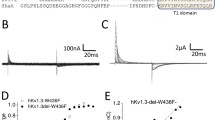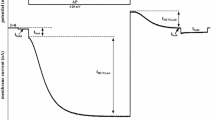Abstract
Follicular oocytes from Xenopus laevis contain K+ channels that are activated by members of the recently recognized class of vasorelaxants that includes the pinacidil derivative P1060. These channels are blocked by antidiabetic sulphonylureas such as glibenclamide. Opening of the glibenclamide-sensitive K+ channels with P1060 promotes follicular oocyte maturation. Whole-cell and single-channel patch-clamp configurations were used to monitor K+ channel activity in isolated follicular cells. In the presence of micromolar concentrations of intracellular Mg2+ ATP, P1060 activated a whole-cell K+ current that was blocked by glibenclamide. The P1060 response was depressed by millimolar concentrations of intracellular ATP and ATP[γS]. Single-channel recordings identified two different types of K+ channel. These channels differed in their unitary conductances (19 pS and 150 pS), in their sensitivities to internal Ca2+, to charybdotoxin and to pinacidil and glibenclamide. Only the Ca2+-independent K+ channel (19 pS) was activated by the pinacidil derivative and blocked by glibenclamide. Opening of the 19-pS glibenclamide-sensitive K+ channel by P1060 critically required the presence of a low concentration of Mg2+ATP in the intracellular medium. The 19-pS K+ channel was opened by increasing intracellular cAMP. Similar effects were obtained by intracellular application of the catalytic subunit of protein kinase A in the presence of micromolar concentrations of Mg2+ATP. Both acetylcholine and the phorbol ester phorbol 12-myristate 13-acetate blocked the 19-pS K+ channel after it was activated by P1060.
Similar content being viewed by others
References
Allard B, Lazdunski M (1992) Nucleotide diphosphates activate the ATP-sensitive potassium channel in mouse skeletal muscle. Pflügers Arch 422:185–192
Amoroso S, Schmid-Antomarchi H, Fosset M, Lazdunski M (1990) Glucose, antidiabetic sulphonylureas and neuro-transmitter release. Role of ATP-sensitive K+ channels. Science 247:852–854
Ashcroft SJH, Ashcroft FM (1990) Properties and functions of ATP-sensitive K+ channels. Cell Sig 2:197–214
Ashcroft FM, Harrison DE, Ashcroft SJH (1984) Glucose induces closure of single potassium channels in isolated rat pancreatic β cells. Nature 312:446–447
Ashford MLJ, Sturgess NL, Trout NJ, Gardner NJ, Hales CN (1988) Adenosine-5′-triphosphate-sensitive ion channels in neonatal rat cultured central neurones. Pflügers Arch 412: 297–304
Beech DJ, Bolton T (1989) Properties of the cromakalim-induced potassium conductance in smooth muscle cells isolated from the rabbit portal vein. Br J Pharmacol 98:851–864
Carl SB, Gelband CH, Sanders KM, Hume JR (1992) Cromakalim and lemakalim activate Ca2+-dependent K+ channels in canine colon. Pflügers Arch 421:67–76
Cook DL, Hales CN (1984) Intracellular ATP directly blocks K+ channels in pancreatic β cells. Nature 311:271–273
Dascal N (1987) The use of Xenopus oocytes for the study of ion channels. CRC Crit Rev Biochem 22:318–387
De Weille JR, Lazdunski M (1989) Regulation of the ATP-sensitive potassium channel. In: Narahashi T (ed) Ion channels, vol 2. New York, pp 205–222
De Weille JR, Fosset M, Epelbaum J, Lazdunski M (1992) Effectors of ATP-sensitive K+ channels inhibit the regulatory effects of somatostatin and GH-releasing factor on growth hormone secretion. Biochem Biophys Res Commun 187: 1007–1014
De Weille JR, Müller M, Lazdunski M (1992) Activation and inhibition of ATP-sensitive K+ channels by fluorescein derivatives. J Biol Chem 267:4557–4563
Dunne MJ, Petersen OH (1986) Intracellular ADP activates K+ channels that are inhibited by ATP in an insulin-secreting cell line. FEBS Lett 208:59–62
Dunne MJ, Petersen OH (1991) Potassium selective ion channels in insulin-secreting cells: physiology, pharmacology and their role in stimulus-secretion coupling. Biochim Biophys Acta 1071:67–82
Edwards G, Weston AH (1990) Structure-activity relationship of K+ channel openers. Trends Pharmacol Sci 11:417–422
Escande D, Thuringer D, Leguern S, Cavero I (1988) The potassium channel opener cromakalim (BRL 34915) activates ATP-dependent K+ channels in isolated cardiac myocytes. Biochem Biophys Res Commun 154:620–625
Faivre JF, Findlay I (1989) Effects of tolbutamide and diazoxide upon action potentials recorded from rat ventricular muscle. Biochim Biophys Acta 984:1–5
Findlay I (1988) Effects of ADP upon the ATP-sensitive K+ channel in rat ventricular myocytes. J Membr Biol 101:83–92
Findlay I, Dunne MJ (1986) ATP maintains ATP-inhibited K+ channels in an operational state. Pflügers Arch 407:238–240
Fosset M, De Weille JR, Green RD, Schmid-Antomarchi H, Lazdunski M (1988) Antidiabetic sulfonylureas control action potential in heart cells via high affinity receptors that are linked to ATP-dependent K+ channels. J Biol Chem 263: 7933–7936
Gelband CH, Lodge NJ, Van Breemen C (1989) A Ca2+-activated K+ channel from rabbit aorta: modulation by cromakalim. Eur J Pharmacol 167:201–210
Hamill OP, Marty A, Neher E, Sakmann B, Sigworth J (1981) Improved patch-clamp techniques for high-resolution current recording from cells and cell-free membrane patches. Pflügers Arch 391:85–100
Hamilton TC, Weir SW, Weston AH (1986) Comparison of the effects of BRL 34915 and verapamil on electrical and mechanical activity in rat portal vein. Br J Pharmacol 88:103–111
Häusser M, De Weille JR, Lazdunski M (1991) Activation by cromakalim of pre-and post-synaptic ATP-sensitive K+ channel in substantia nigra. Biochem Biophys Res Commun 174:909–914
Honoré E, Lazdunski M (1991) Hormone-regulated K+ channels in follicle-enclosed oocytes are activated by vasorelaxing K+ channel openers and blocked by antidiabetic sulfonylureas. Proc Natl Acad Sci USA 88:5438–5442
Honoré E, Lazdunski M (1991) Two different types of channels are targets for potassium channel openers in Xenopus oocyte. FEBS Lett 287:75–79
Kajioka S, Kitamura K, Kuriyama H (1991) Guanosine-di-phosphate activates an adenosine 5′-triphosphate-sensitive K+ channel in the rabbit portal vein. J Physiol (Lond) 444:397–418
Kakei M, Noma A (1984) ATP-sensitive single K+ channel in the atrioventricular node cell of the rabbit heart. J Physiol (Lond) 352:265–285
Klöckner U, Trieschmann U, Isenberg G (1989) Pharmacological modulation of calcium and potassium channels in isolated vascular smooth muscle cells. Arzneimittelforschung 1:120–126
Kusano K, Miledi R, Stinnakre J (1977) Acetylcholine receptors in the oocyte membrane. Nature 270:739–741
Lederer WJ, Nichols CG (1989) Nucleotide modulation of the activity of rat heart ATP-sensitive K+ channels in isolated membrane patches. J Physiol (Lond) 419:139–211
Lotan I, Dascal N, Cohen S, Lass Y (1982) Adenosine-induced slow ionic currents in the Xenopus oocyte. Nature 298:572–574
Noma A (1983) ATP-regulated potassium channels in cardiac muscle. Nature 305:147–148
Notsu T, Tanaka I, Mizota M, Yanagibashi K, Fukutake K (1992) A cAMP-dependent protein kinase inhibitor modulates the blocking action of ATP and 5-hydroxydecanoate on the ATP-sensitive K+ channel. Life Sci 51:1851–1856
Okabe K, Kajioka S, Nakao K, Kitamura K, Kuriyama H, Weston AH (1990) Actions of cromakalim on ionic currents recorded from single smooth muscle cells of the rat portal vein. J Pharmacol Exp Ther 252:832–839
Petersen OH, Findlay I (1987) Electrophysiology of the pancreas. Physiol Rev 67:1054–1116
Quast U, Cook NS (1989) Moving together, K+ channels openers and ATP-sensitive K+ channels. Trends Pharmacol Sci 10:431–435
Rehm H, Pelzer S, Cochet C, Tempel B, Chambaz E, Trautwein W, Pelzer D, Lazdunski M (1989) Dendrotoxin binding brain membrane protein displays a K+ channel activity that is stimulated by both cAMP-dependent and endogenous phosphorylations. Biochemistry 28:6455–6460
Ribalet B, Ciani S (1987) Regulation by cell metabolism and adenine nucleotides of a K channel in insulin-secreting cell (RINmSF). Proc Natl Acad Sci USA 84:1721–1725
Ribalet B, Ciani S, Eddlestone GT (1989) ATP mediates both activation and inhibition of K(ATP) channel activity via cAMP-dependent protein kinase in insulin-secreting cell lines. J Gen Physiol 94:693–717
Rorsman P, Trube G (1985) Glucose dependent K+ channels in pancreatic β cells are regulated by intracellular ATP. Pflügers Arch 405:305–309
Rorsman P, Trube G (1990) Biophysics and physiology of ATP-regulated K+ channels (KATP). In: Cook NS (ed) Potassium channels: structure, classification and therapeutic potential. Ellis Horwood, Chichester, pp 96–116
Sakuta H, Sekiguchi M, Okamoto K, Sakai Y (1992) Inactivation of glibenclamide-sensitive K+ channels in Xenopus oocytes by various calmodulin antagonists. Eur J Pharmacol 226:199–207
Sanguinetti MC, Scott AL, Zingaro GJ, Siegl PKS (1988) BRL 34915 (cromakalim) activates ATP-sensitive K+ current in cardiac muscle. Proc Natl Acad Sci USA 85:8360–8364
Schmid-Antomarchi H, De Weille JR, Fosset M, Lazdunski M (1987) The receptor for antidiabetic sulfonylureas controls the activity of the ATP-modulated K+ channel in insulin-secreting cells. J Biol Chem 262:15 840–15 844
Schmid-Antomarchi H, Amoroso S, Fosset M, Lazdunski M (1990) K+ channel openers activate brain sulfonylurea-sensitive K+ channels and block neurosecretion. Proc Natl Acad Sci USA 87:3489–3492
Spruce AE, Standen NB, Stanfield PR (1987) Studies of the unitary properties of adenosine 5′-trisphosphate-regulated potassium channels of frog skeletal muscle. J Physiol (Lond) 382:213–236
Standen NB, Quayle JM, Davies NW, Brayden JE, Huang Y, Nelson MT (1989) Hyperpolarizing vasodilators activate ATP-sensitive K+ channels in arterial smooth muscle. Science 245:177–180
Tseng GN, Hoffman BF (1990) Actions of pinacidil on membrane currents in canine ventricular myocytes and their modulation by intracellular ATP and cAMP. Pflügers Arch 414:414–424
Van Renterghem C (1984) Courant de potassium provoqué par un agoniste β adrénergique sur le follicule ovarien de Xenopus laevis, rôle médiateur de l'AMPc, inhibition par l'acétylcholine. Ph.D Thesis, Université Pierre et Marie Curie
Van Renterghem C, Penit-Soria J, Stinnakre J (1985) β adrenergic induced K+ current in Xenopus oocytes: role of cAMP, inhibition by muscarinic agents. Proc R Soc Lond [Biol] 223:389–402
Wibrand F, Honoré E, Lazdunski M (1992) Opening of glibenclamide-sensitive K+ channel in follicular cells promotes Xenopus oocyte maturation. Proc Natl Acad Sci USA 89:5133–5137
Woll KH, Lönnendonker U, Neumcke B (1989) ATP-sensitive potassium channels in adult mouse skeletal muscle: different modes of blockage by internal cations, ATP and tolbutamide. Pflügers Arch 414:622–628
Author information
Authors and Affiliations
Additional information
This work was supported by the Centre National de la Recherche Scientifique (CNRS) and the Fondation pour la Recherche Médicale (FRM)
Rights and permissions
About this article
Cite this article
Honoré, E., Lazdunski, M. Single-channel properties and regulation of pinacidil/glibenclamide-sensitive K+ channels in follicular cells from Xenopus oocyte. Pflugers Arch. 424, 113–121 (1993). https://doi.org/10.1007/BF00374601
Received:
Revised:
Accepted:
Issue Date:
DOI: https://doi.org/10.1007/BF00374601




